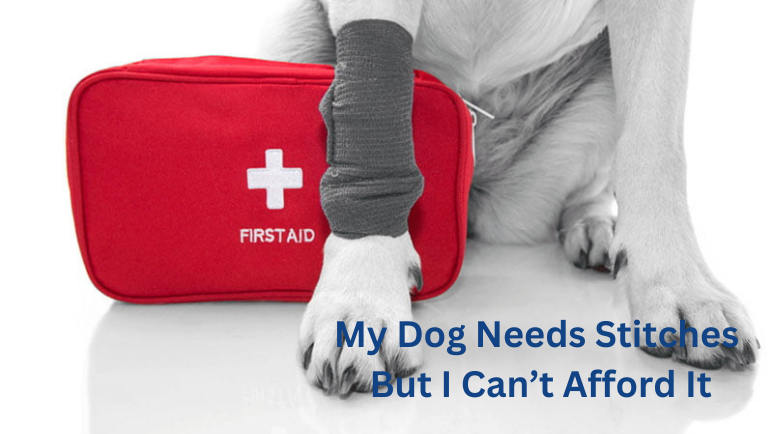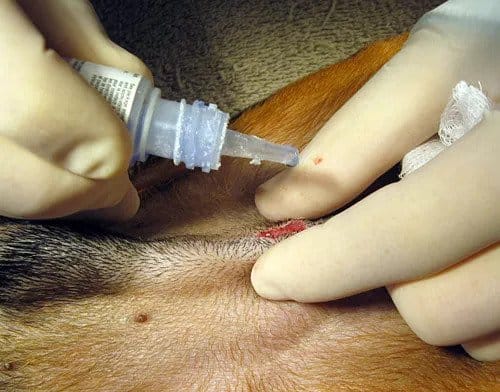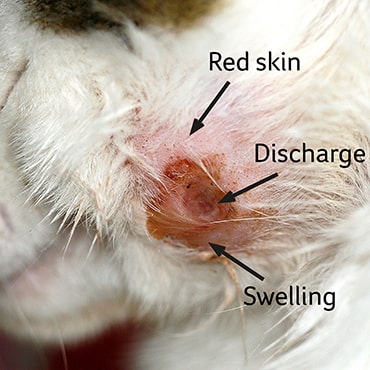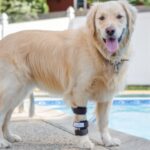Imagine you are playing fetch with your dog in the park when suddenly he runs into a sharp branch and cuts his leg. You rush to his side and see blood dripping from the wound. You panic and wonder what to do. How serious is the injury? Does he need stitches? Can you afford them? If you have ever been in this situation, My dog needs stitches but I can’t afford it you are not alone.
According to a study by the American Veterinary Medical Association, more than 4 million dogs get injured and need stitches every year in the US. Stitches are important for dogs because they help close the wound, prevent infection, and promote healing. However, stitches can also be expensive, ranging from $200 to $3000 depending on the size and location of the wound.
Leaving a wound untreated can have serious consequences for your dog, such as pain, inflammation, abscess, sepsis, or even death. Therefore, it is essential to find a way to treat your dog’s wound as soon as possible. In this paper, I will argue that there are ways to treat your dog’s wound without stitches if you can’t afford them, but you should always consult a vet first and follow their instructions carefully.
Immediate Care for Your Dog’s Wound
If You Can’t Afford Stitches
One of the most important steps in treating your dog’s wound is to stop the bleeding and clean the wound. This will reduce the risk of infection and help the wound heal faster. To stop the bleeding, you need to apply pressure on the wound with a clean cloth or gauze pad for at least 10 minutes.
Do not remove the cloth or gauze until the bleeding stops, as this may reopen the wound. If the blood soaks through the cloth or gauze, add another layer on top of it, but do not remove the original one. If the bleeding does not stop after 20 minutes, you should seek veterinary attention immediately, as your dog may have a severed artery or vein.
Cleaning the Wound
Once the bleeding has stopped, you need to clean the wound with a mild antiseptic solution, such as iodine or betadine. These solutions can kill bacteria and prevent infection. You can use a cotton ball or a syringe to gently apply the solution to the wound and the surrounding area.
Do not use alcohol, hydrogen peroxide, or soap, as these can irritate the wound and delay healing. You should also trim away any hair that may interfere with the wound care.
Preventing Infection
To prevent infection, you need to keep the wound clean and dry. You should change the bandage at least once a day, or more often if it becomes wet or dirty. You should also apply a thin layer of antimicrobial ointments, such as Neosporin or bacitracin, to the wound before covering it with a bandage.
This will help keep the wound moist and prevent scabs from forming. Scabs can interfere with healing and increase the risk of scar formation. You should also monitor the wound for any signs of infection, such as redness, swelling, pus, foul odor, or fever. As soon as you see any of these symptoms, you should get in touch with your veterinarian.
How to Assess the Severity of the Wound
Measuring the Wound and Checking for Signs of Damage
After stopping the bleeding and cleaning the wound, you need to assess how serious the wound is and whether it needs stitches or not. To do this, you need to measure the depth, length, and width of the wound, and check for any signs of tissue damage, nerve damage, or bone exposure.
You can use a ruler or a tape measure to get the dimensions of the wound, and a flashlight or a magnifying glass to inspect the wound closely. You should also gently touch the wound and observe your dog’s reaction to see if there is any pain or numbness.
Determining the Need for Stitches
Some wounds are more likely to need stitches than others, depending on their size, location, and severity. Generally, stitches are necessary when the wound is larger than half an inch, when it is located on a joint or a paw pad, or when it is bleeding profusely or spurting blood.
These wounds are more prone to infection, reopening, or healing poorly. Stitches can help close the gap between the skin edges, prevent dirt and bacteria from entering the wound, and promote faster and better healing.
However, stitches are not always required for smaller, shallower, or less severe wounds. These wounds can heal on their own with proper care and protection. You should consult your vet to determine whether your dog’s wound needs stitches.
How to Treat Your Dog’s Wound Without Stitches
My dog needs stitches but I can’t afford it, if you fall into such a situation at the vet clinic, so you don’t lose hope. There are some alternatives to stitches that you can use at home or with the help of a low-cost clinic.
However, you should always consult your vet before using any of these methods, as they may not be suitable for every wound or every dog.
Alternatives to Stitches
Some of the alternatives to stitches are:
Butterfly bandages: These are adhesive strips that can hold the skin edges together and close small wounds. They are easy to apply and remove, and they can reduce scarring and infection. However, they may not work well for deep, large, or irregular wounds, or for wounds on areas that move a lot, such as joints or paws.
Skin glue: This is a special type of glue that can bond the skin edges together and seal minor wounds. It is quick and painless to apply, and it can dissolve on its own after a few days. However, it may not be strong enough for deep, large, or bleeding wounds, or for wounds on areas that are hairy, oily, or moist.
Staples: These are metal clips that can close moderate to large wounds by piercing the skin and holding it together. They are faster and cheaper than stitches, and they can reduce inflammation and infection. However, they require a special tool to apply and remove, and they may cause more pain and scarring than stitches.
How to Use Alternatives to Stitches
If you decide to use any of these alternatives to stitches, you should follow these steps:
Clean the wound thoroughly with iodine or betadine and dry it with gauze. Apply the alternative method of your choice according to the instructions on the package or from your vet.
Cover the wound with a sterile bandage and change it daily or as needed.
Monitor the wound for any signs of infection, such as redness, swelling, pus, foul odor, or fever.
Remove the alternative method after the recommended period or when the wound is healed.
Sources of Financial Assistance
Besides using alternatives to stitches, you can also look for some sources of financial assistance that can help you pay for your dog’s wound care. Some of the suggestions are:
Pet insurance: This is a type of insurance that covers some or all of the costs of veterinary care for your pet. It can save you money in case of emergencies or chronic conditions. However, it may not cover pre-existing conditions or cosmetic procedures, and it may have deductibles, co-pays, or limits. You should compare different plans and providers before choosing one that suits your needs and budget.
Crowdfunding: This is a way of raising money online from people who are willing to donate to your cause. You can create a campaign on a platform like GoFundMe or PetFundMe and share your story and your goal amount. You can also offer rewards or incentives for donors, such as updates, photos, or thank-you notes. However, you should be honest and transparent about your situation and how you will use the funds, and you should be prepared to pay fees or taxes on the donations.
Credit line: This is a type of loan that allows you to borrow money up to a certain limit and pay it back over time with interest. You can use it to pay for unexpected expenses like veterinary bills. However, you should be careful about your credit score and your ability to repay the debt, as it may affect your future borrowing options and financial stability.
Pet saving account: This type of bank account you can set up specifically for your pet’s expenses. You can deposit money regularly into this account and use it when needed. This way, you can save money in advance and avoid going into debt. However, you should be disciplined about your saving habits and avoid withdrawing money for other purposes.
Animal charities: These are nonprofit organizations that provide financial assistance or low-cost services for pet owners who are struggling. Some examples include the ASPCA, RedRover, and the Humane Society. They may have different eligibility criteria and application processes, so you should check their websites or contact them directly for more information.
Low-cost clinics: These are veterinary clinics that offer affordable or subsidized care for pets. They may provide basic services like vaccinations, spay/neuter, or microchipping, or more advanced services like surgery or dentistry. They may be run by animal shelters, animal welfare groups, veterinary schools, or private veterinarians]. Search online or ask around for low-cost clinics near you.
By exploring these options, you can find a way to treat your dog’s wound without breaking the bank. However, you should always prioritize your dog’s health and well-being over anything else. Remember, it’s always best to seek professional veterinary care for proper diagnosis and treatment.
How Much Does It Cost to Get Stitches for Dogs?
Factors that Affect the Cost of Stitches
- The type of stitch: traditional, dissolvable, or skin glue
- The location of the wound: face, paw, or other areas
- The veterinarian performing the procedure: fees, experience, or equipment
The cost of dog stitches can vary widely depending on several factors, such as the type of stitch, the location of the wound, and the veterinarian performing the procedure. According to some web search results. the average cost of stitches for dogs is around $200, but it can range from $50 to $3000 or more. The following are some variables that may impact the price:
The type of stitch: Different types of stitches can be used to close a dog’s wound, such as traditional, dissolvable, or skin glue. Each type has its pros and cons, such as cost, durability, pain, and healing time. For example, traditional stitches are more expensive and require removal, but they are stronger and more secure than dissolvable stitches or skin glue.
- The location of the wound: The location of the wound can influence the cost of stitches, as some areas are more sensitive or difficult to access than others. For example, wounds on the face, paw, or other movable areas may require more stitches or anesthesia than wounds on the body or limbs.
- The veterinarian performing the procedure: The veterinarian performing the procedure can also affect the cost of stitches, as different vets may have different fees, experience, or equipment. For example, some vets may charge more for emergency or after-hours services, while others may offer discounts or payment plans for low-income pet owners.
The best way to find out how much it costs to get stitches for your dog is to consult your vet and get an estimate based on your dog’s specific condition and needs. You can also look for some sources of financial assistance or alternatives to stitches if you can’t afford them.
However, you should always prioritize your dog’s health and well-being over anything else. Remember, it’s always best to seek professional veterinary care for proper diagnosis and treatment.
How do I know if my dog needs stitches or not?
If your dog has a wound, you may wonder if it needs stitches or not. Stitches are important for dogs because they help close the wound, prevent infection, and promote healing. However, stitches can also be expensive and painful for your dog.
Signs that Your Dog Needs Stitches
To know if your dog needs stitches, you should look for the following signs: the wound is deep, larger than half an inch, or exposes bone or muscle; the wound is bleeding profusely or does not stop bleeding after applying pressure.
The wound is located on the face, paw, or other sensitive or movable area; the wound is causing your dog a lot of pain or discomfort; the wound is dirty or infected. If you are unsure, it is always best to take your dog to a vet for an exam.
What are some signs of infection in a dog’s wound?
That’s a good question. Infections can be very dangerous for dogs, so it’s important to know how to recognize them. Here are some signs of infection in a dog’s wound:
- Redness or swelling around the wound
- Tenderness or pain when touching the wound
- Discharge (especially bloody or yellow) from the wound
- Fever or loss of appetite
- Lethargy or overgrooming the wound
- A foul odor or dark-colored discharge from the wound
- Vomiting or diarrhoea
- Bleeding easily
If you notice any of these signs, you should contact your vet right away. They can examine the wound and prescribe the appropriate treatment. Some infections may require antibiotics, anti-inflammatory drugs, or surgery. You should also keep the wound clean and dry, and prevent your dog from licking or biting it. Infections can slow down the healing process and cause complications, so don’t ignore them.
Conclusion
my dog needs stitches but I can’t afford it, is a very painful situation for someone but don’t worry we explained different ways to your dog’s wound without stitches. you should always consult a vet first and follow their instructions carefully.
You should stop the bleeding and clean the wound, assess the severity of the wound and decide whether it needs stitches or not, and explore your options for alternatives to stitches or financial assistance.
These steps are important for your dog’s health and well-being, as they can prevent infection, pain, scarring, and complications. However, you should remember that these are not substitutes for professional veterinary care and that your dog deserves the best treatment possible.
Therefore, we urge you to take your dog to a vet as soon as possible and follow their advice. You can also do more research on how to care for your dog’s wound at home or find more resources on how to afford veterinary care. Your dog is your loyal friend and companion, and he needs your love and support in this difficult time.
FAQs About My Dog Needs Stitches But I Can’t Afford It
Q: How do I know if my dog needs stitches or not?
A: You should look for the following signs that indicate that your dog’s wound needs stitches: the wound is deep, larger than half an inch, or exposes bone or muscle; the wound is bleeding profusely or does not stop bleeding after applying pressure; the wound is located on the face, paw, or other sensitive or movable area; the wound is causing your dog a lot of pain or discomfort; the wound is dirty or infected1. If you are unsure, it is always best to take your dog to a vet for an exam.
Q: How do I clean my dog’s wound?
A: You should clean your dog’s wound by following these steps: put on disposable gloves and clip the fur around the wound with electric clippers; flush the wound with sterile saline or warm water to remove any dirt or debris; apply a mild antiseptic solution, such as iodine or betadine, to the wound and the surrounding area; pat the wound dry with a clean cloth, gauze, or paper towel and cover it with a sterile bandage; change the bandage daily or as needed and monitor the wound for signs of infection.
Q: What are some alternatives to stitches for my dog’s wound?
A: Some of the alternatives to stitches for your dog’s wound are: butterfly bandages, which are adhesive strips that can hold the skin edges together and close small wounds; skin glue, which is a special type of glue that can bond the skin edges together and seal minor wounds; staples, which are metal clips that can close moderate to large wounds by piercing the skin and holding it together. However, you should always consult your vet before using any of these methods, as they may not be suitable for every wound or every dog.
Q: How can I find financial assistance for my dog’s wound care?
A: You can look for some sources of financial assistance that can help you pay for your dog’s wound care, such as: pet insurance, which is a type of insurance that covers some or all of the costs of veterinary care for your pet; crowdfunding, which is a way of raising money online from people who are willing to donate for your cause; credit line, which is a type of loan that allows you to borrow money up to a certain limit and pay it back over time with interest; pet saving account, which is a type of bank account that you can set up specifically for your pet’s expenses; animal charities, which are nonprofit organizations that provide financial assistance or low-cost services for pet owners who are struggling; low-cost clinics, which are veterinary clinics that offer affordable or subsidized care for pets.
Q: How do I prevent my dog from licking or scratching his stitches?
A: You can prevent your dog from licking or scratching his stitches by following these tips: put a cone collar on your dog or wrap a bandage around his stitches to stop him from licking or scratching them; keep him calm and limit his activity and playing with other dogs while his stitches heal; distract him with toys, treats, or mental stimulation; check his stitches regularly and look for signs of irritation or infection; contact your vet if you notice any problems or if your dog seems uncomfortable.







